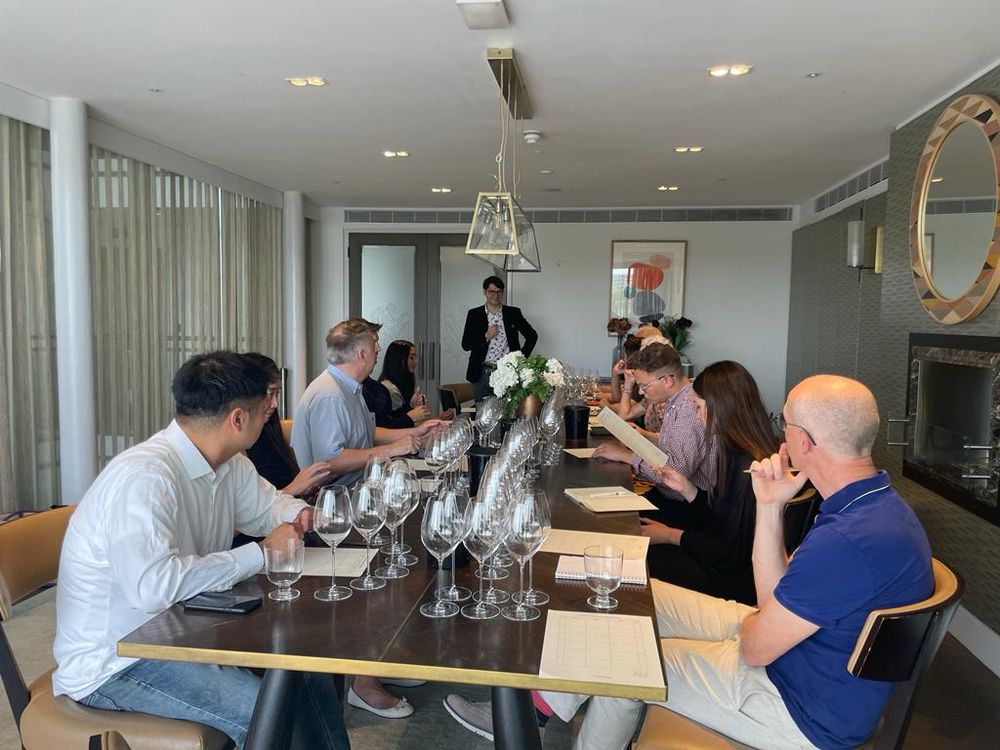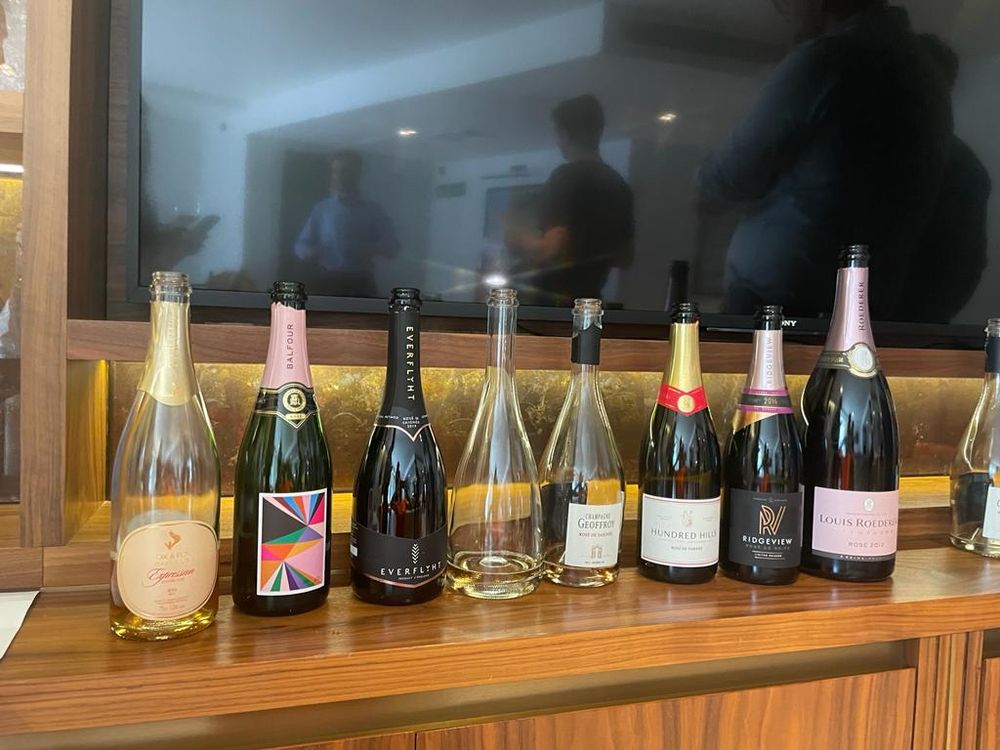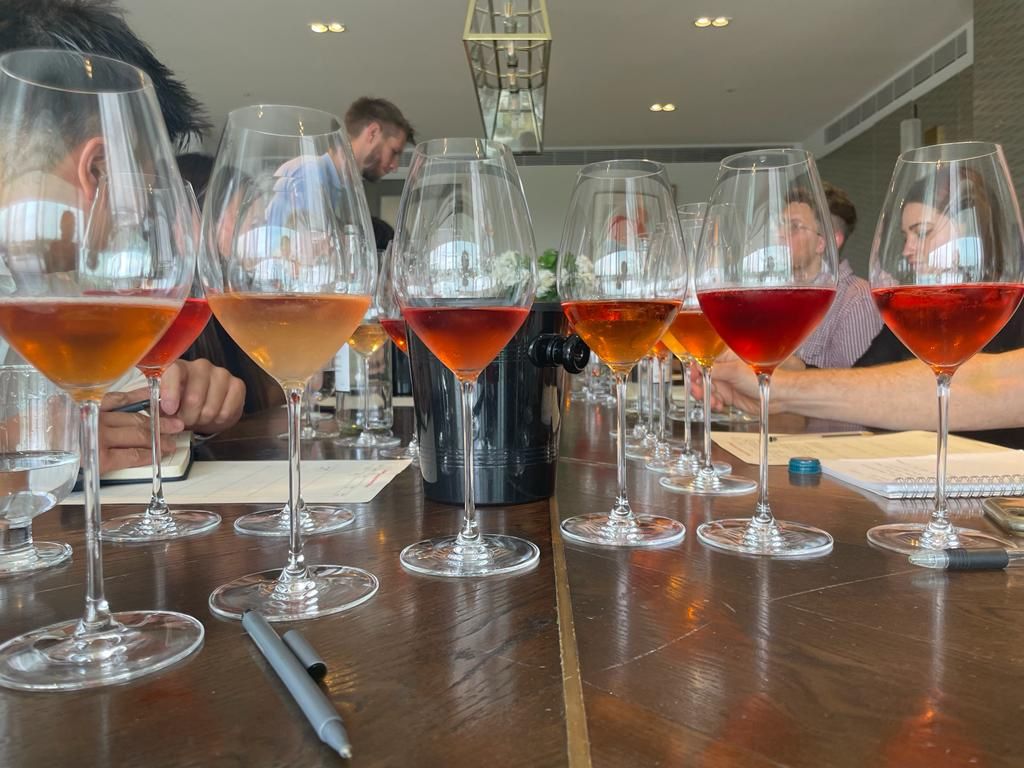“I am sure we will see lots of English sparkling rosé made in this way,” says Nick Baker from The Finest Bubble, about English saignée rosé.

Douglas Blyde kicks off proceedings at the English saignée rosé tasting, September 2, 2022, Battersea Power Station
Like many UK-based wine enthusiasts, the rapid evolution of the English and Welsh wine scene is a source of continuing wonderment. So an invitation to attend quite possibly the first blind tasting of a range of English saignée rosé was an opportunity not to be missed.
Briefly, saignée translates as ‘bleeding’ in French. In sparkling winemaking a rosé is made mainly through two ways: ‘assemblage’ which is adding between 7% and 15% red wine (usually Pinot Noir) into the blend. Less common and more labour-intensive is the saignée method which is allowing the colour from the skins of the red grapes during pressing into the blend. This skin contact usually varies between 12 and 24 hours with the shade of the wine taking on a darker hue the longer the contact.
The saignée method usually produces wines of a darker hue than rosé made through assemblage and arguably produces wines with a richer tasting experience – more concentrated fruit flavours and terroir characteristics. When it is used in Champagne it tends to be mentioned on the label, perhaps most famously by Louis Roederer, which says its Cristal Rose is partly made using the saignée technique, which involves bleeding off juice after several days of cold maceration.
Nick Baker of The Finest Bubble explains that maceration and saignée are basically interchangeable terms here.
“Saignée for sparkling wine is exactly the same in production as they do in Champagne, the word is interchangeable with maceration, which is common for Champagnes like Laurent-Perrier Brut Rosé, Louis Roederer Vintage Rosé and also Cristal where it is skin contact for a short period that brings out the colour and fruit, without too long a maceration that extracts bitter tannins and phenolics.”
“So, unless some of the English Sparkling producers are doing something different to this, then to me saignée is just a winemaking choice where you choose to macerate or make a red wine separately and blend it into the wine at tirage. You see sparkling’s made from maceration all colours, from pale like Louis Roederer Cristal Rose to the more densely coloured like the Hundred Hills Saignée Rosé 2018 which is much more vibrant, but a lot of that will be its youthfulness.”
“I am sure we will see lots of English Sparkling Rosé made in this way,” he adds.
The English saignée rosé tasting
Now I love a blind tasting – it’s been the default setting for the wine club I have been member of for 15 plus years. It’s a proud moment when one of us occasionally guesses the grape correctly so it was with some trepidation that I contemplated how I would add any value to the tasting process in hand. The format was six wines with a couple of late curveball additions – in fact could I even think of six English sparkling rosé producers? (I could think of three). Fortunately the format was simply to score the wines in terms of appearance, aroma and palate and we could mark our own homework.
I was one of 12 judges drawn from a pool of winemakers, sommeliers, merchants, writers and influencers and we each had to judge the wine to a 20-point scale.

There were eight wines blind-tasted in all – six made predominantly in England with two incursions from Champagne – and, in order of scores, they were…
- Hundred Hills 2018, 100% Pinot Noir (£180 per three in bond, Atlas Fine Wines): 190
- Roederer 2012 Rosé (£188 per magnum, The Finest Bubble): 178
- Fox & Fox Mayfield Expression Rosé de Saignée 2014 (£42, Fox & Fox) : 177
- Everflyht Rosé de Saignée 2019, 60% Pinot Noir/40% Pinot Meunier (£40, Everflyht): 176
- Ridgeview Rosé de Noirs 2016 (£60, The Finest Bubble): 173
- Hambledon 1er Cru Rosé based on 2016 – very recently disgorged (not yet released): 169
- Geoffroy Rosé de Saignée Brut 1er Cru based on 2016, 100% Pinot Noir (£52, Harvey Nichols): 165.5
- And Balfour Rosé de Saignée 2018, 45% Pinot Noir, 35% Chardonnay, 15% Pinot Meunier and 5% Pinot Blanc (£40, Balfour): 157.5
NB: one judge would not share their scores.
The look of these wines is hugely appealing ranging from the orange/ amber Fox & Fox to the almost Clairet appearance of the Hundred Hills. No insipid Provence Rosé hues to be seen here.
Aromatically, these wines are almost all hugely complex and inviting with signature notes of apple, redcurrant and strawberry (the only outlier being the more herbal Balfour). They all unfurled in the glass over the course of the tasting.
On the palate you cannot help but be struck by the lovely purity of the fruit (typically there is no fining or filtering), and the power and structure that is on offer. Coupled with lashings of trademark English acidity, it’s clear that these wines are intensely gastronomic. Indeed at Alain Ducasse the Hundred Hills is recommended as a partner for game dishes, an application recommended by wine expert Douglas Blyde who chaired proceedings: “True saignée offers a genuine representation of our soils and, when darker and richer, offers tremendous suitability to game.”
What the winemakers think about English saignée rosé
It is clear that some of the winemakers behind the wines we tasted have a very different perspective on this new category.
Stephen Duckett, whose Hundred Hills 2018 pipped the Louis Roederer to the post, lauded its ability to express the purity of Pinot Noir: “With the need for perfect ripeness, while still retaining good acidity, a saignée rose is perhaps the perfect expression of Pinot Noir in England today. With hand selected bunches, barrel fermentation, no fining and no filtering the saignée from Hundred Hills is as pure an expression of English Pinot Noir vintage by vintage as you can experience anywhere.”
Luke Spalding, general manager at Everflyht agrees, adding that the saignée method emphasises grape quality, variety and vintage: “For me the Rosé de Saignée method allows you to show the qualities of the varieties used (with Everflyht that is Pinot noir and Meunier) and the resulting style has purity and phenolic complexity that puts the onus on the grape quality and vintage.”
Fergus Elias at Balfour emphasised the importance of the vintage and raised doubt as to whether they would be making another in the near future.
“2018 was the vintage of the decade for English wines with super high-quality fruit and yield… a wine which practically made itself! This wine was made out of curiosity and is a style that we might not return to as it can be quite phenolic and green due to the ripeness of the stems and seeds. It requires the very best vintages to be successful.”
Jonica Fox of Fox & Fox says “Aged saignée is different from most people’s experience of pink fizz so that’s the only general point I’d make. It’s about setting their expectations I think – made with minimal manipulation, no mallow, aged on lees.”
So in conclusion…
To my mind these are not wines to quaff or serve as an aperitif as they lack the elegance and finesse of a traditionally assembled sparkling rosé. So commercially this style of winemaking is likely to remain a fascinating niche, particularly for sommeliers to explore.































